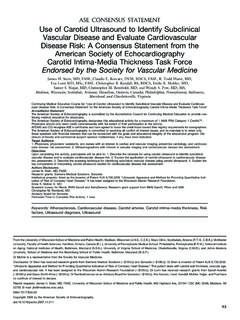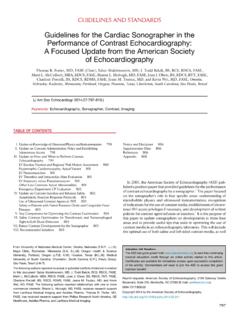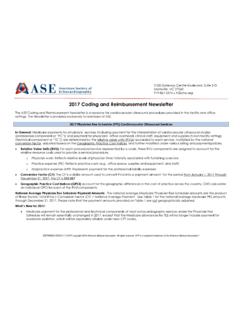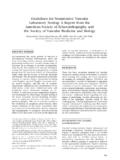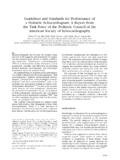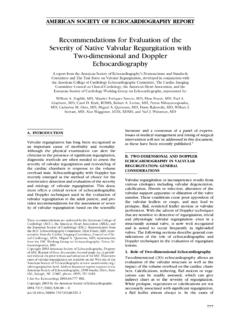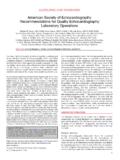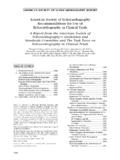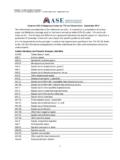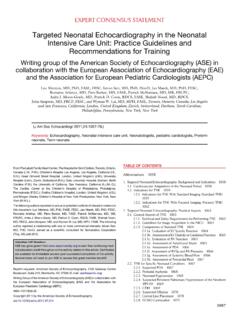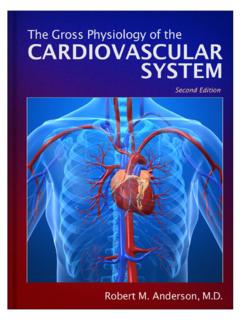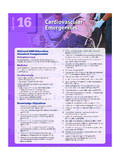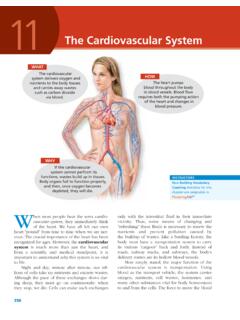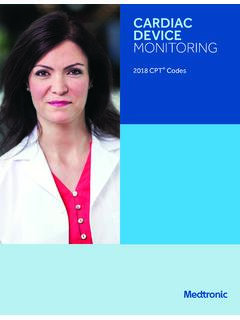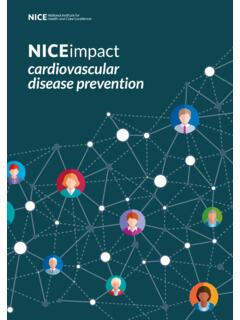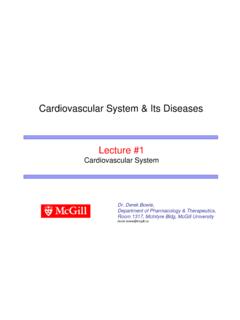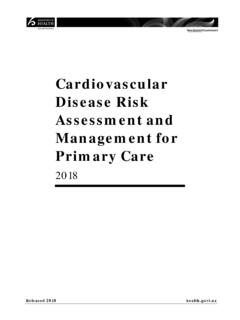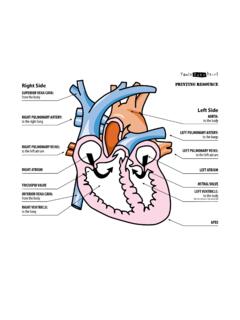Transcription of Recommendations for the Evaluation of Left Ventricular ...
1 ASE/EACVI GUIDELINES AND STANDARDSR ecommendations for the Evaluation of LeftVentricular Diastolic Function by Echocardiography:An Update from the American Society ofEchocardiography and the European Associationof cardiovascular ImagingSherif F. Nagueh, Chair, MD, FASE,1 Otto A. Smiseth, Co-Chair, MD, PhD,2 Christopher P. Appleton, MD,1 Benjamin F. Byrd, III, MD, FASE,1 Hisham Dokainish, MD, FASE,1 Thor Edvardsen, MD, PhD,2 Frank A. Flachskampf, MD, PhD, FESC,2 Thierry C. Gillebert, MD, PhD, FESC,2 Allan L. Klein, MD, FASE,1 Patrizio Lancellotti, MD, PhD, FESC,2 Paolo Marino, MD, FESC,2 Jae K.
2 Oh, MD,1 Bogdan Alexandru Popescu, MD, PhD, FESC, FASE,2and Alan D. Waggoner, MHS, RDCS1,Houston, Texas;Oslo, Norway; Phoenix, Arizona; Nashville, Tennessee; Hamilton, Ontario, Canada; Uppsala, Sweden; Ghent andLi ege, Belgium; Cleveland, Ohio; Novara, Italy; Rochester, Minnesota; Bucharest, Romania; and St. Louis, Missouri(J Am Soc Echocardiogr 2016;29:277-314.)Keywords:Diastole, Echocardiography, Doppler, Heart failureTABLE OF CONTENTSI. General Principles for Echocardiographic Assessment of LV DiastolicFunction 278II. Diagnosis of Diastolic Dysfunction in the Presence of NormalLVEF 279 III.
3 Echocardiographic Assessment of LV Filling Pressures and DiastolicDysfunction Grade 281IV. Conclusions on Diastolic Function in the Clinical Report 288V. Estimation of LV Filling Pressures in Specific CardiovascularDiseases 288A. Hypertrophic Cardiomyopathy 289B. Restrictive Cardiomyopathy 289C. Valvular Heart Disease 290D. Heart Transplantation 292E. Atrial Fibrillation 295F. Atrioventricular Block and Pacing 296VI. Diastolic Stress Test 298A. Indications 299B. Performance 299C. Interpretation 301D. Detection of Early Myocardial Disease and Prognosis 301 VII.
4 Novel Indices of LV Diastolic Function 301 VIII. Diastolic Doppler and 2D Imaging Variables for Prognosis in Patientswith HFrEF 303IX. Prediction of Outcomes in Patients with HFpEF 303 Reviewers 306 Notice and Disclaimer 307 From the Methodist DeBakey Heart and Vascular Center, Houston, Texas ( );the University of Oslo, Oslo, Norway ( , ); Mayo Clinic Arizona, Phoenix,Arizona ( ); Vanderbilt University School of Medicine, Nashville, Tennessee( ); McMaster University, Hamilton, Ontario, Canada ( ); UppsalaUniversity, the Institute of Medical Sciences, Uppsala, Sweden ( ); GhentUniversity and University Hospital, Ghent, Belgium ( ); Cleveland Clinic,Cleveland, Ohio ( ).
5 The University of Li ege Hospital, Li ege, Belgium ( );Universita Piemonte Orientale, Novara, Italy ( ); Mayo Clinic, Rochester,Minnesota ( ); the University of Medicine and Pharmacy Carol Davila, Institute of cardiovascular Diseases, Bucharest, Romania ( ); andWashington University School of Medicine, St Louis, Missouri ( ).The following authors reported no actual or potential conflicts of interest in relationto the document: Sherif F. Nagueh, MD, Otto Smiseth, MD, PhD, Christopher , MD, Benjamin F. Byrd III, MD, Hisham Dokainish, MD, Thor Edvardsen,MD, PhD, Frank A.
6 Flachskampf, MD, PhD, Thierry C. Gillebert, MD, PhD, AllanKlein, MD, Patrizio Lancellotti, MD, PhD, Paolo Marino, MD, and Alan D. Wagg-oner, MHS, RDCS. The following authors reported relationships with one ormore commercial interests: Jae K. Oh, MD, has served as a consultant forMedtronic and received a research grant from Toshiba. Bogdan AlexandruPopescu, MD, PhD, has received research support from GE Healthcare and Hita-chi ASE Members:The ASE has gone green! earn free continuingmedical education credit through an online activity related to this are available for immediate access upon successful completionof the activity.
7 Nonmembers will need to join the ASE to access this greatmember benefit!Reprint requests: American Society of Echocardiography, 2100 Gateway CentreBoulevard, Suite 310, Morrisville, NC 27560 Committee of the American Society of Committee of the European Association of cardiovascular $ 2016 by the American Society of assessment ofleft Ventricular (LV) diastolicfunction is an integral part ofthe routine Evaluation of patientspresenting with symptoms ofdyspnea or heart failure. The2009 American Society ofEchocardiography (ASE) andEuropean Association of Echo-cardiography (now EuropeanAssociation of CardiovascularImaging [EACVI]) guidelines fordiastolic function assessmentwere comprehensive, includingseveral two-dimensional (2D)
8 And Doppler parameters tograde diastolic dysfunction andto estimate LV filling , the inclusionof many parameters in the guide-lines was perceived to renderdiastolic function assessmenttoo complex, because severalreaders have interpreted theguidelines as mandating all thelisted parameters in the docu-ment to fall within specifiedvalues before assigning a specificgrade. The primary goal of thisupdate is to simplify theapproach and thus increase theutility of the guidelines in dailyclinical diastolic dysfunction isusually the result of impairedLV relaxation with or withoutreduced restoring forces (andearly diastolic suction), andincreased LV chamber stiffness,which increase cardiac fillingpressures.
9 Thus, when perform-ing an echocardiographic studyin patients with potential dia-stolic dysfunction, one shouldsearch for signs of impaired LVrelaxation, reduced restoringforces and increased diastolicstiffness. More important, LVfilling pressure should be esti-mated because elevated LV dia-stolic pressure in the absence ofincreased LV end-diastolic vol-ume is strong evidence in favorof well-developed diastolicdysfunction. In the majority of clinical studies, LV filling pressuresand diastolic function grade can be determined reliably by a fewsimple echocardiographic parameters with a high feasibility.
10 In addi-tion, technical developments have emerged that provide newindices that appear promising for studying LV diastolic update places more emphasis on applying the most useful,reproducible, and feasible 2D and Doppler measurements fromthe 2009 applying the guidelines, it is essential to consider what the termLV filling pressuresrefers to. The termLV filling pressurescan refer to meanpulmonary capillary wedge pressure (PCWP) (which is an indirect esti-mate of LV diastolic pressures), mean left atrial (LA) pressure (LAP), LVpre-A pressure, mean LV diastolic pressure, and LVend-diastolic pressure(LVEDP).
